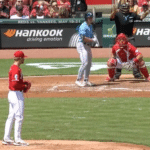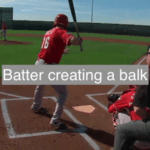WINDUP POSITION
Rule 5.07(a)(1):
Pitchers assume the windup position in one of three ways:
(1) Facing the batter, hands together, pivot foot in contact with the rubber, other foot free. This is the “traditional” windup position. From this position (hands together), any natural movement associated with his delivery of the ball to the batter commits the pitcher to pitch without interruption.
(2) Facing the batter, hands apart (usually at the side), pivot foot in contact with the rubber, other foot free. From this windup position, the pitcher goes directly into his delivery to the batter. If the pitcher uses this windup position (hands at side), the first movement of his hands or arms or feet that is associated with his delivery commits the pitcher to pitch.
(3) Facing the batter, hands apart, pivot foot in contact with the rubber, other foot free. From this position (hands apart), the pitcher receives the sign from the catcher and then brings his hands together in a stationary position (“pause”) before beginning the delivery. Once the pitcher’s hands are together, the pitcher is in the “traditional” windup position. If a pitcher uses this windup position, the act of bringing his arms up and positioning his hands in front of his body shall not be construed as the start of his actual delivery UNLESS some other action is initiated by another part of his body simultaneously and is associated with the actual delivery.
Any of the three positions described above is considered a legal windup position, and from such windup position (regardless of whether the pitcher’s hands are together or apart), the pitcher may:
(1) deliver the ball to the batter, or
(2) step and throw to a base in an attempt to pick off a runner, or
(3) disengage the rubber by stepping back with his pivot foot first. (Disengaging the rubber by stepping back with his free foot first is a balk when runners are on base regardless of whether the pitcher’s hands are together or apart.)
From any of the three types of windup positions referred to in this section, the pitcher may step and throw to a base in an attempt to pick off a runner (i.e., the pitcher is not required first to step off). Although this is not frequently seen, it is legal provided the pitcher does not make any motion associated with his delivery to the batter before the pitcher throws to the base.
Play: Bases loaded, pitcher in windup position. Before making any motion associated with his delivery of the pitch to the batter, the pitcher turns, steps, and throws to second (or to first or to third) in one continuous motion in an attempt to pick off the runner.
Ruling: Legal move.
TO CLARIFY:
(1) If the pitcher’s hands are held together in front of his body in a stationary position before the pitcher delivers to the batter, the preliminary action of bringing his hands together is not interpreted as the start of the actual windup or delivery to the batter. If, however, this preliminary action is accompanied by any other natural movement that is associated with the delivery to the batter, then the pitcher is committed to pitch without altering or interrupting his delivery once such motion is initiated.
(2) If a pitcher does not assume a stationary, hands-together position prior to initiating his actual delivery, any natural movement associated with the start of their delivery commits the pitcher to pitch.
From the windup position, the pitcher may not go into a set or stretch position—if he does so, it is a balk when runners are on base.
In the windup position, the pitcher must have both feet squarely on the ground.
In 2006, the Official Playing Rules Committee made a number of changes to the Windup Position. Those changes took effect at the Major League level in 2007.
The changes allow a pitcher to have only a portion of his pivot foot, rather than the entire foot, in contact with the rubber. Furthermore, in the windup position, a pitcher is allowed to have his free foot at either side of the rubber, in front of the rubber, on the rubber, or behind the rubber, and to step to either side of the rubber—all of which are commonly accepted current practices. Previous editions of the Official Baseball Rules prohibited this.
Under the rules adopted in 2007,
(a) Only a portion of the pitcher’s pivot foot must be in contact with the rubber (no longer “entire pivot foot”). This applies to both windup and set positions. Under the new rules, pitchers may pitch “off the end” of the rubber, as long as any part of the pivot foot is in contact with the rubber.
(b) In the windup position, the pitcher’s free foot may be on the rubber, in front of the rubber, to the side of the rubber, or behind the rubber.
(c) In the windup position, the pitcher is permitted to step to the side during his delivery (previously prohibited).




